澤龜種類繁多,各具特色,成為水族愛好者的寵兒。提供合適的營養是健康飼養的關鍵,此篇文章會根據澤龜野外的食物組成,找出適合澤龜所需的營養成分。
【鮮蝦研究室】澤龜的營養需求與對幾丁質的攝取(上)
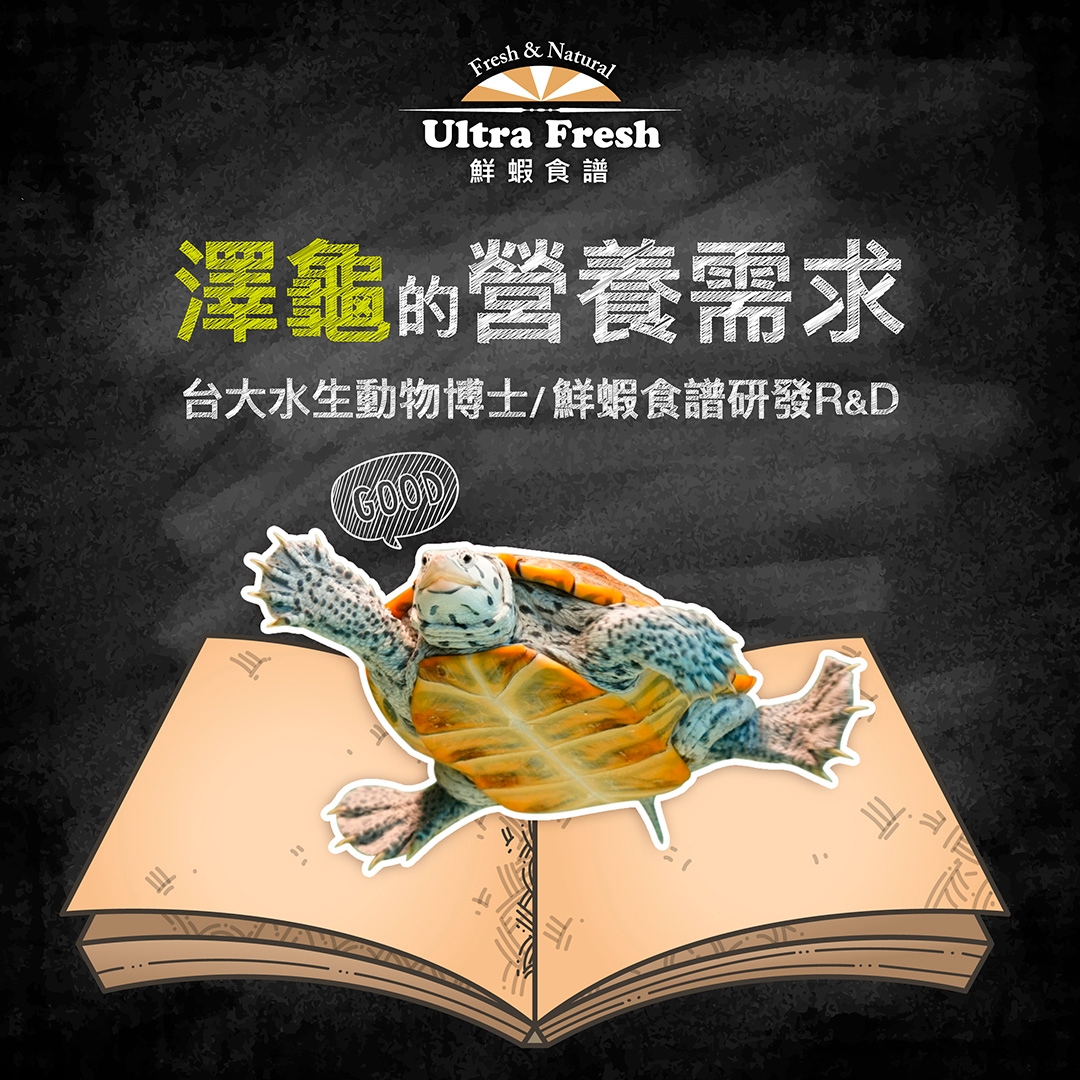
台大水生動物博士/鮮蝦食譜研發𝗥&𝗗
龜鱉目 (Testudines) 底下的動物目前已知超過300多種。先撇開動物分類學不論,依照龜鱉們的生物特性 (食性、棲地偏好、外形等),可以將牠們粗略分為陸龜 (tortoise) 和澤龜 (turtle) 兩大類型。其中,澤龜通常偏好棲息在水域裡、水域附近或是環境溼度較高的環境裡。許多種類的澤龜具有色彩紋路獨特、飼養難度不高、入手容易、存在感強等特性,深受許多朋友喜愛,是觀賞水族市場中流通量相當大的水族寵物之一。因為如此,專業的廠商們也順應市場的需求而開發出許多與澤龜飼養相關的設備、飼料與水質調理產品等,幫助有意飼養與親近澤龜的朋友更容易上手。
鮮蝦食譜參考大部份澤龜在野外棲地中的食物組成,以整隻劍蝦為主要原料之一,並且根據各別不同發育階段的澤龜對營養的需求與餌食尺寸的適口性,在搭配其他多種不同動植物性原料研發與測試後,鮮蝦食譜成功開發出幼澤龜、亞成澤龜與成澤龜等多款澤龜專用飼料。
◑澤龜野外的食物組成大不同
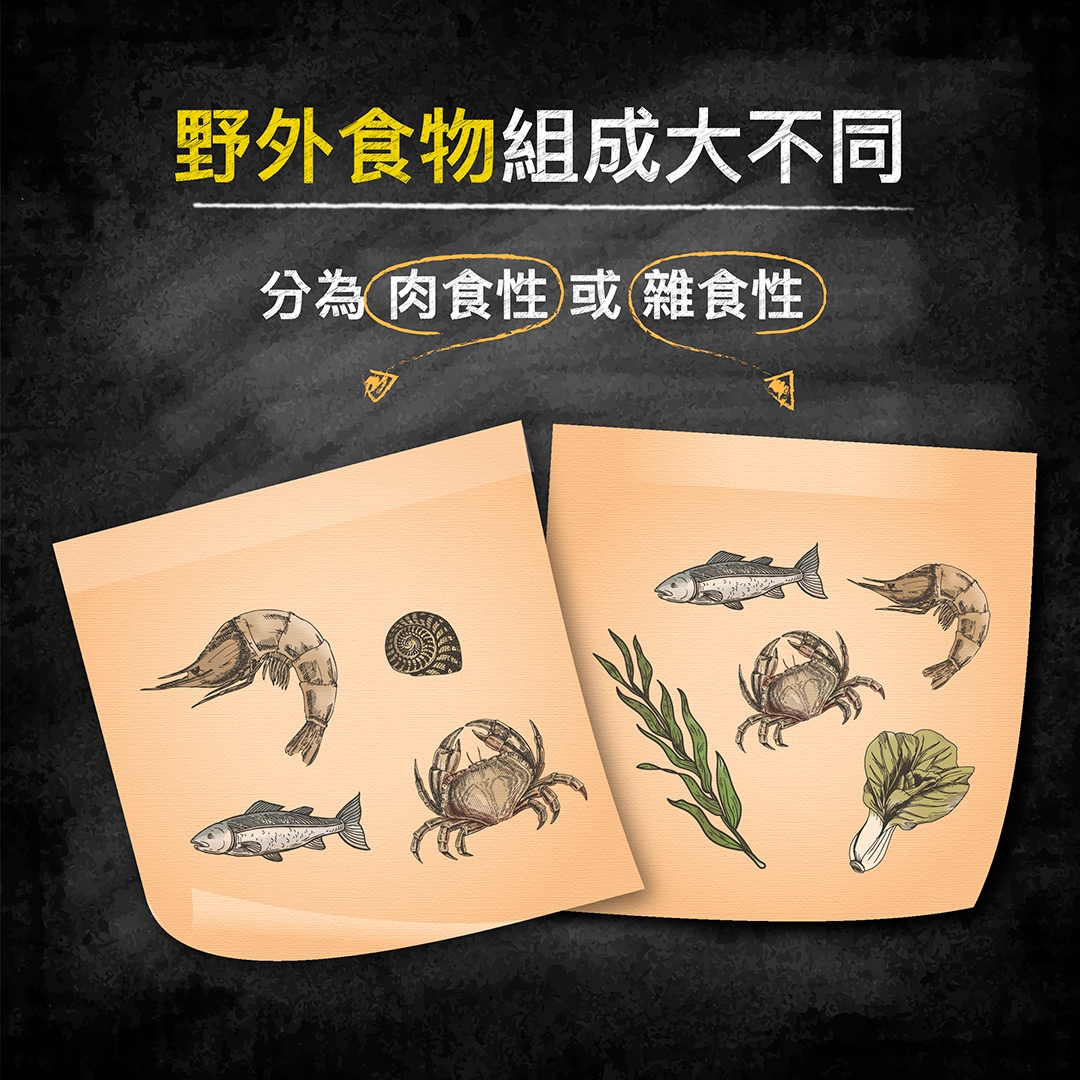
澤龜的種類繁多,各有各的地理分佈、棲息環境、食性偏好與食物組成來源。表1整理自數個研究報導中多種澤龜的野外食物組成,其中也包含好幾種在市場中流通量較大的龜種。根據這些調查的結果,不同種類的澤龜在野外的食物組成常不相同。在食性上,澤龜屬於機會主義的肉食性或雜食性 (opportunistic carnivores or omnivores),也就是在日常活動中遇到什麼合牠們胃口的就吃什麼。因此,依牠們的喜好和棲地中的可獲得性,不同澤龜們的食物可能會包含各種的無脊椎動物 (特別是軟體動物、節肢動物、環節動物等)、脊椎動物、藻類、植物枝葉或碎屑,甚至真菌。不過,值得特別注意的是,無論是什麼種類的澤龜,牠們食譜中最大的共同點就是都含有大量的節肢動物,像是水生或陸生昆蟲、蝦蟹螯蝦等甲殼類動物、蜘蛛、馬陸或蜈蚣等。
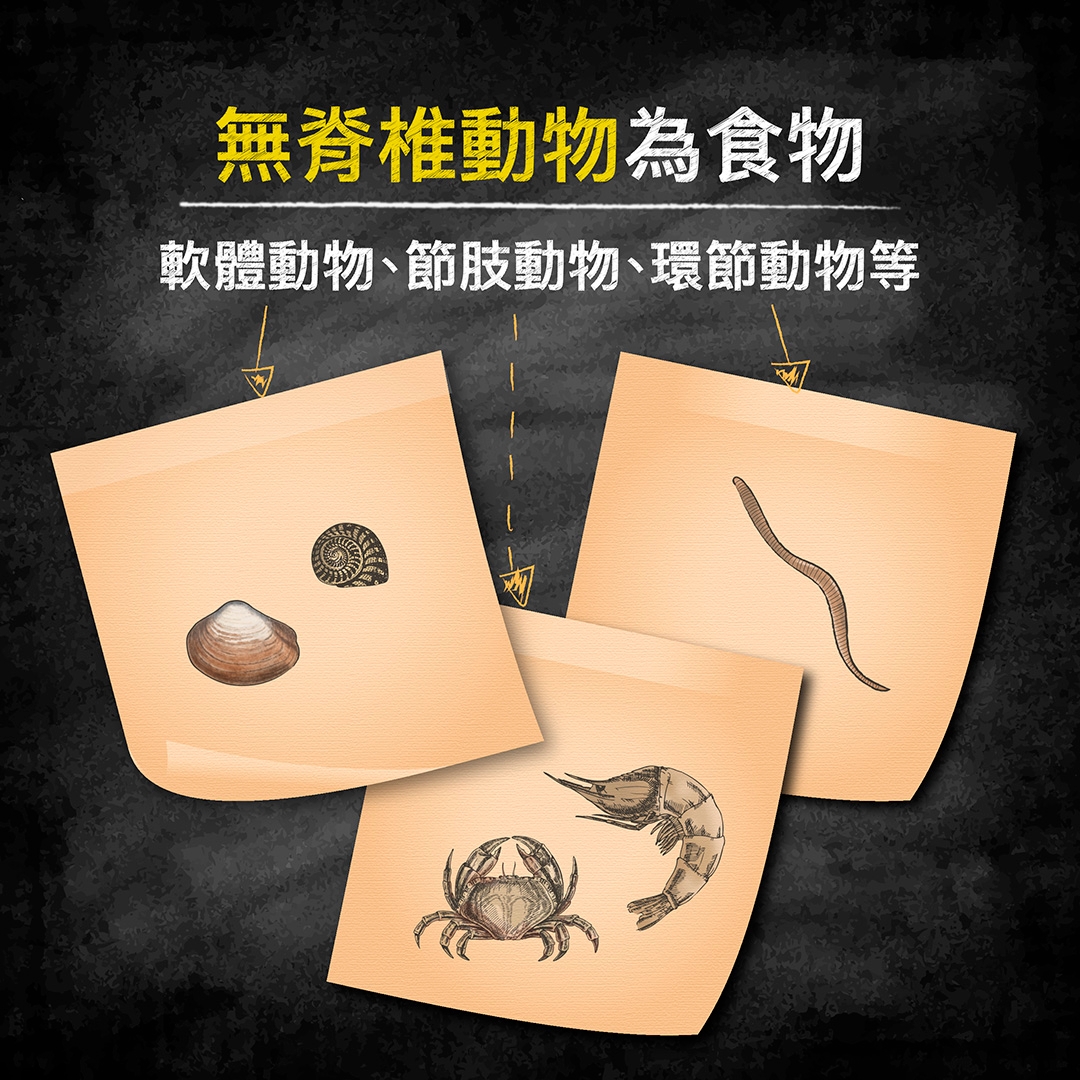
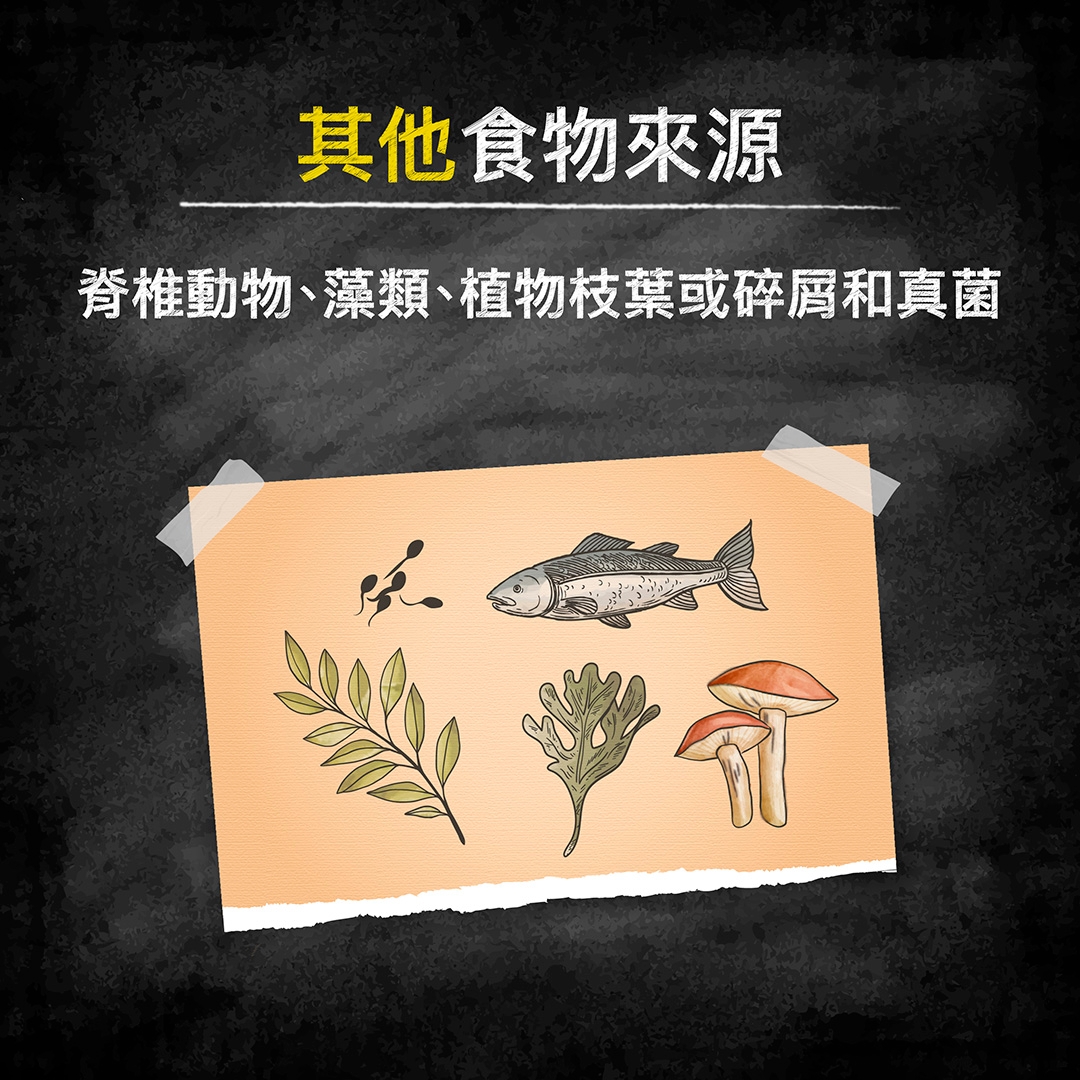
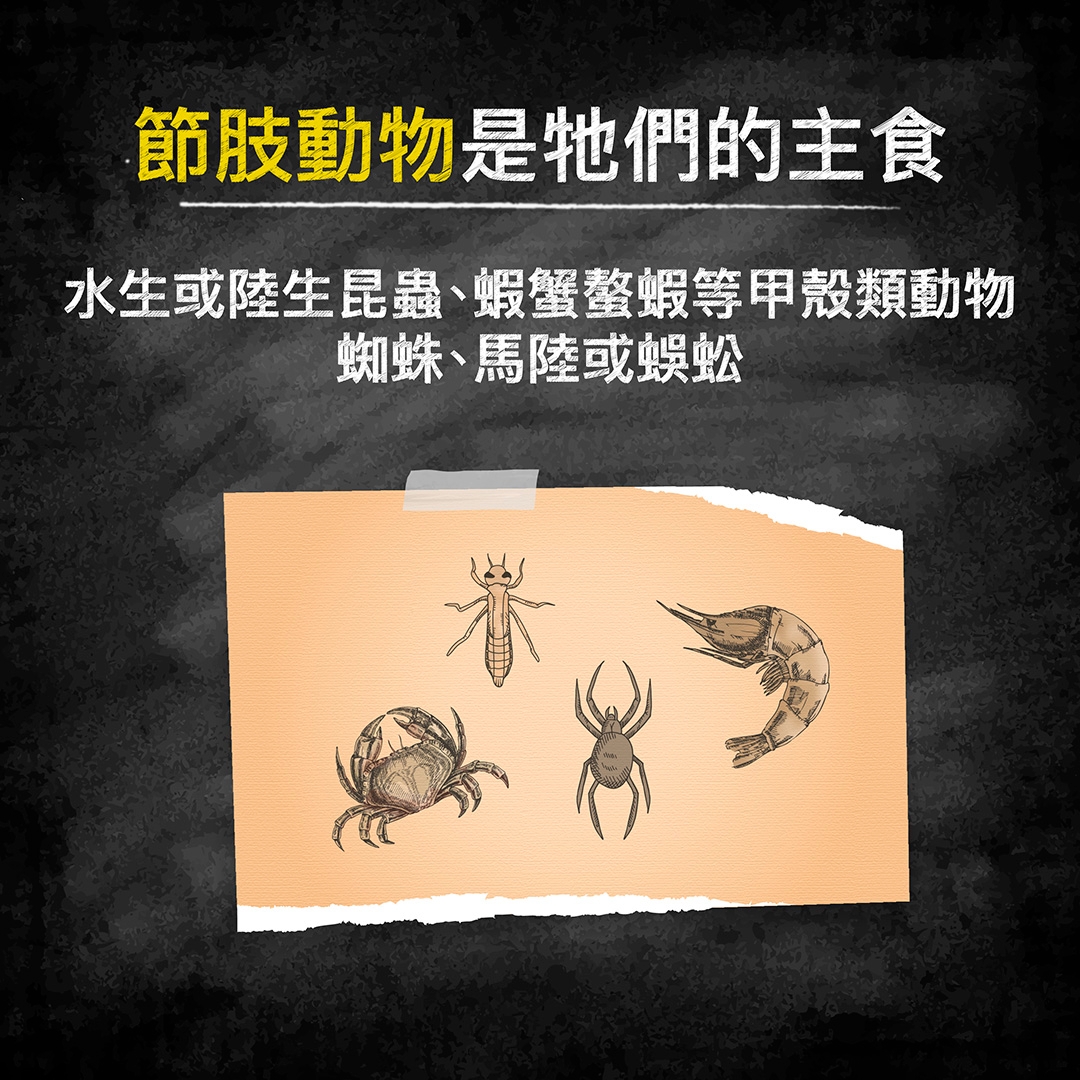
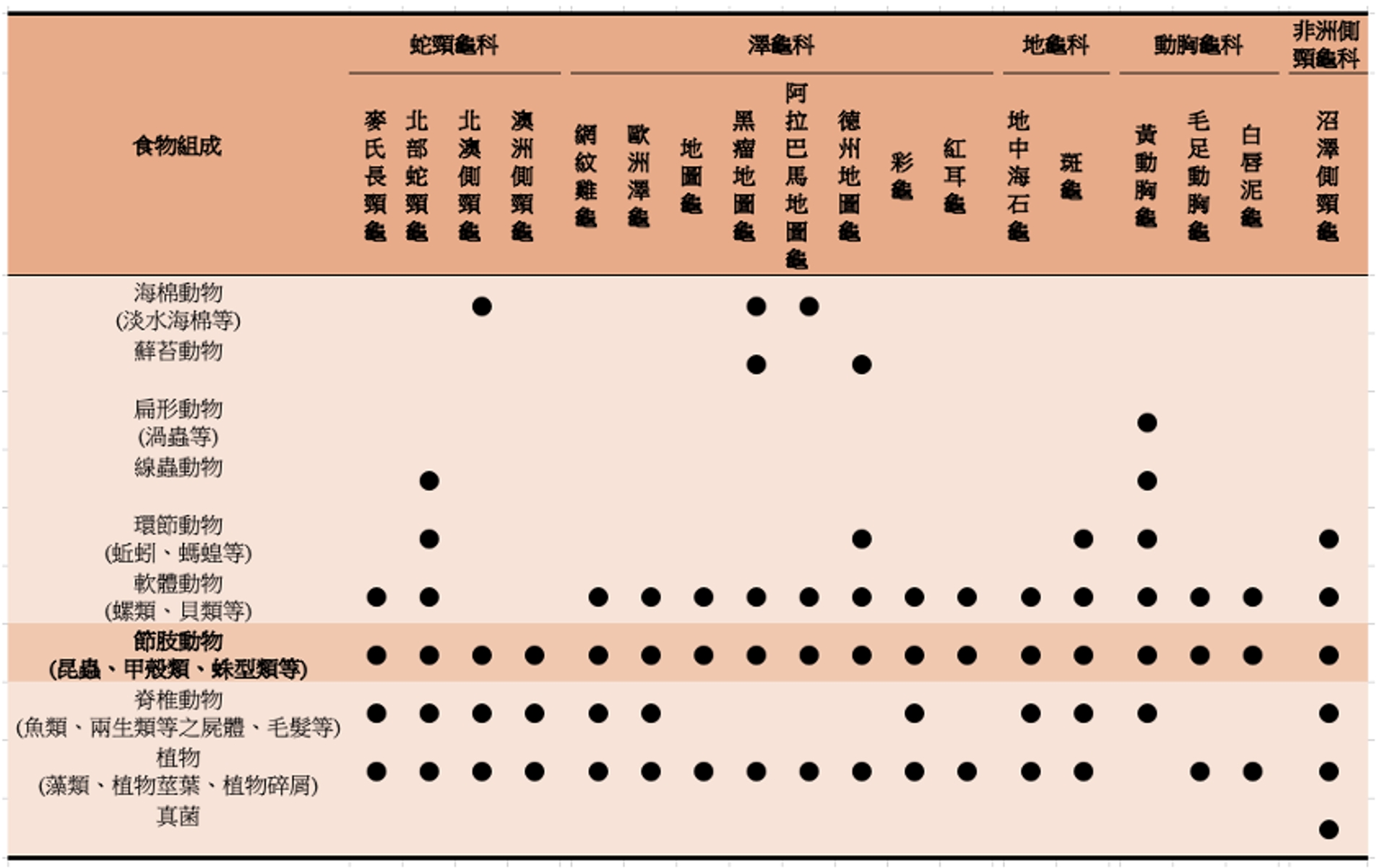 表1.部分種類澤龜於野外的食物組成
表1.部分種類澤龜於野外的食物組成
◑澤龜的營養需求
提供合適且營養充足的餌食,是飼養澤龜的第一步。但很遺憾地,因為澤龜的種類繁多,又極度缺乏相關的營養學研究,因此到目前為止尚確乏一套經過科學驗證、完全適用於所有種類澤龜營養需求的標準。即便如此,我們還是可以透過參考極少數被研究過的龜種數據來獲得一些可供依循的通則,尤其是中華鼈 (Chinese softshell turtle, Pelodiscus sinensis)。
因為有人類食用的需求,中華鼈是在亞洲地區最被大量繁養殖的澤龜物種之一,水產營養學家們對於牠的食物營養需求也研究地較為透徹。一般而言,處於快速成長階段的小鼈食性極偏向肉食,成長的表現會與餌食中的蛋白質含量呈現正相關。換句話說,對處於快速生長期的小鼈而言,食物中的蛋白質含量建議要較高,需維持在39.0%-46.5%之間。除了考量總蛋白質外,其中所含的胺基酸組成也須留心,食物中需至少要含有足夠的半光胺酸 (Cysteine) 、甲硫胺酸 (Methionine)、牛磺酸 (Taurine)等。不過,當中華鼈達到性成熟、體型增加的速度也降緩之後,對於日常餌食中蛋白質的需求便會稍微降低。再者,為了促進中華鼈的成長速度,餌食中的建議脂肪含量可提高至8.8%。此外,因為殼與骨骼結構的發達,中華鼈對餌食中的鈣質需求量大,且其中的鈣/磷比需高於2:1。過低的鈣/磷比會造成中華鼈的殼發育畸型與生長遲緩。最後,礦物質 (鎂、鐵、鋅、銅等) 與維他命 (維生素A、C、D3、E等) 也都被證實是中華鼈成長與進行正常生理作用時所需的營養成份。
需要特別提醒的一點是,前文中所提供的數據資訊針對的是以食用為目的而在繁養殖場中進行培養的中華鼈,餌食中營養成份含量的建議值主要考量為讓牠們能夠快速生長,以越短的時間達到上市體型越佳。當我們把這份資訊當作通則並且套用到其他以不同目的進行飼養 (例如當作家庭寵物) 的不同種澤龜身上時,就需要依照實際的長時間飼養觀察來測試與拿捏,並且視個體的狀況進行調整。例如,當把澤龜當作寵物「健康養」,不需要用高蛋白高脂肪的餌食去衝高其成長速度時,餌食中的蛋白質和脂肪含量就可以往下調。又或者,有文獻曾報導,紅臉蛋龜 (Kinosternon scorpioides) 成龜的食物可維持較低的蛋白質含量 (26%);但當為了培養繁殖用的種母時,食物中蛋白質含量若提高到60%以上時則在產卵量和卵質都可有顯著的增加。
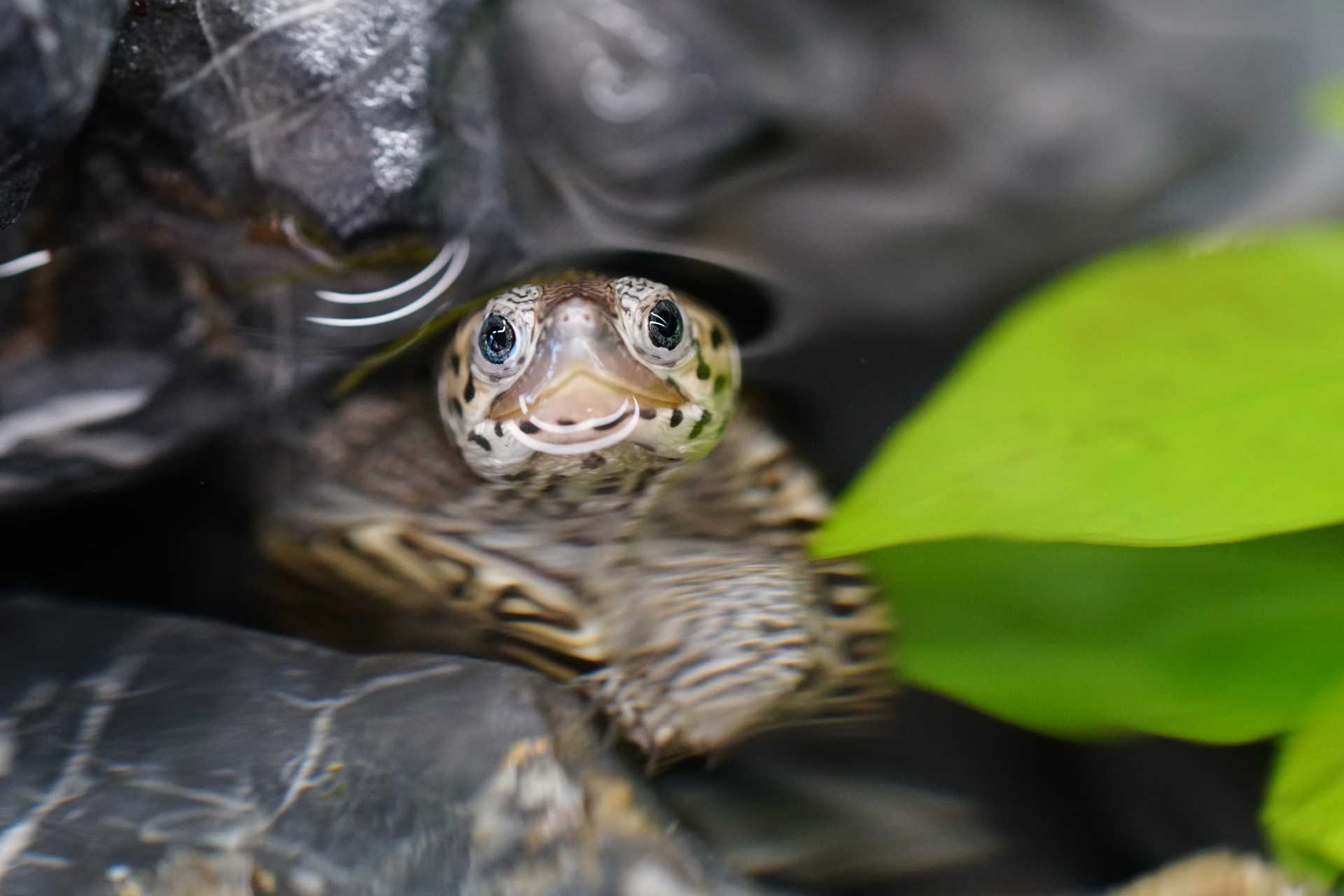
目前市面上有販售的澤龜飼料至少有十多種。匯整各品牌澤龜飼料公開在網際網路上的營養成份標示內容,一般市售澤龜飼料的粗蛋白平均為37.5% (16.2%-52%);粗脂肪平均為5.9% (1.8%-10.5%);粗纖維平均為4.2% (0.5%-12.6%);含水份平均為9.0% (6.0%-12.0%) (表2)。飼料中會使用像是魚粉 (含魚肉與副產物)、甲殼動物 (南極蝦粉、蝦粉、勾蝦等)、昆蟲 (麵包蟲、蟋蟀等)、軟體動物 (貽貝等)、雞肉粉或豬肉豬骨粉等動物性原料,以及小麥粉、黃豆粉、樹薯澱粉、玉米粉、小麥胚芽與藻類 (螺旋藻等)等植物性原料。鮮蝦食譜針對澤龜所設計的菜單,則使用了整隻劍蝦與其他甲殼動物 (毛蝦與金勾蝦)、沙丁魚與魷魚作為主要的動物性原料,並且添加桑葉、玉米、海帶、紅蘿蔔、南瓜、高麗菜、海帶與螺旋藻等豐富的植物性原料,以各種原型食物來提供多元且充分的營養元素。較高的蛋白質含量可以供澤龜成長與維持日常活動所需;較低的脂肪含量可避免澤龜過於肥胖;較低的飼料含水量則能降低微生物活性與確保飼料在使用期間的品質和安全 (表2)。

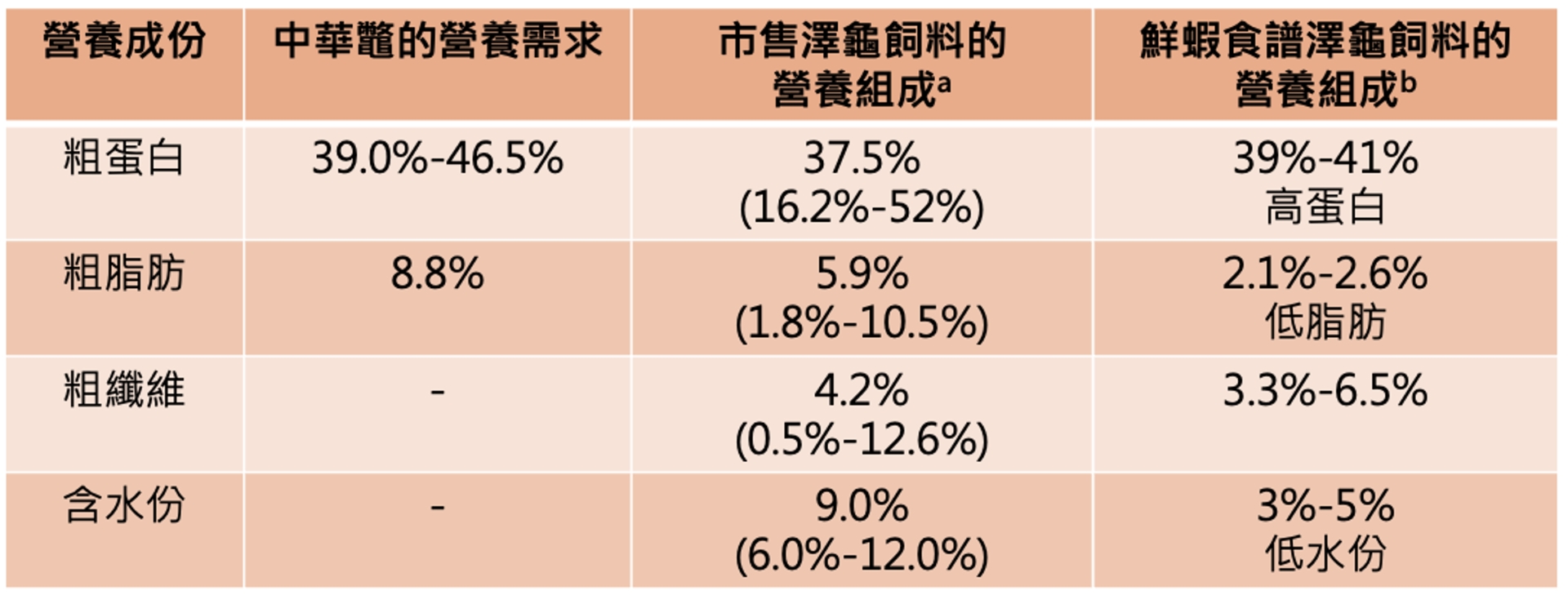
 表2.中華鱉的營養需求與市售澤龜飼料組成
表2.中華鱉的營養需求與市售澤龜飼料組成
◑參考文獻
Ceballos C. P., Zapata D., Alvarado C., Rincon E. (2016) Morphology, diet, and population structure of the southern white-lipped mud turtle Kinosternon leucostomum postinguinale (Testudines: Kinosternidae) in the Nus River drainage, Colombia. Journal of Herpetology 50(3): 374-380.
Chen T.-H., Lue K.-Y. (1998) Ecology of the Chinese stripe-necked turtle, Ocadia sinensis (Testudines: Emydidae), in the Keelung River, northern Taiwan. Copeia 1998(4): 944-952.
Chen T.-H., Lue K.-Y. (1999) Food habits of the Chinese stripe-necked turtle, Ocadia sinensis, in the Keelung River, northern Taiwan. Journal of Herpetology 33(3): 463-471.
Cloudsley-Thompson J. L. (1999) Nutritional Diversity. In: The Diversity of Amphibians and Reptiles: An Introduction, pp 109-129.
Da Costa Araujo J., e Rosa P.V., das Dores Correia Palha M., Rodrigues P.B., de Freitas R.T.F., do Socorro Lima da Silva A. (2013) Effect of three feeding management systems on some reproductive parameters of Scorpion mud turtles (Kinosternon scorpioides) in Brazil. Trop. Anim. Health Prod. 45: 729-735.
Demuth J. P., Buhlmann K. A. (1997) Diet of the turtle Deirochelys reticularia on the Savannah River site, South Carolina. Journal of Herpetology 31(3): 450-453.
Gades M.D., Stern J.S. (2003) Chitosan supplementation and fecal fat excretion in men. Obesity Research 11(5): 683-688.
Gibbons J.W. ed. (1990) Life history and ecology of the slider turtle. Waschington D.C., USA, Smithsonian Institution Press.
Jeuniaux C. (1961) Chitinase: an addition to the list of hydrolases in the digestive tract of vertebrates. Nature 192(4798): 135-136.
Kennett Rod., Tory O. (1996) Diet of two freshwater turtles, Chelodina rugosa and Elseya dentata (Testudines: Chelidae) from the wet-dry tropics of northern Australia. Copeia 1996(2): 409-419.
Koide S.S. (1998) Chitin-chitosan: properties, benefits and risks. Nutrition. research 18(6): 1091-1101.
Kou S., Peters L., Mucalo M. (2021) Chitosan: A review of sources and preparation methods. International Journal of Biological Macromolecules 169: 85-94.
Kumar M.N.V.R. (2000) A review of chitin and chitosan applications. Reactive and functional polymers 46(1): 1-27.
Lindeman P. V. (2006) Diet of the Texas map turtle (Graptemys versa): relationship to sexually dimorphic trophic morphology and changes over five decades as influenced by an invasive mollusk. Chelonian Conservation and Biology 5(1): 25-31.
Lindeman P. V. (2016) Diets of syntopic black-knobbed sawbacks (Graptemys nigrinoda) and Alabama map turtles (Graptemys pulchra) in the Alabama River. The American Midland Naturalist 175: 194-205.
Luiselli L., Akani G.C., Ebere N., Rugiero L., Vignoli L., Angelici F.M., Eniang E.A., Behangana M. (2011) Food Habits of a Pelomedusid Turtle, Pelomedusa subrufa, in Tropical Africa (Nigeria): The Effects of Sex, Body Size, Season, and Site. Chelonian Conservation and Biology 10(1):138- 144.
McArthur S., Wilkinson R., Meyer J, ed. (2008) Medicine and surgery of tortoises and turtles. John Wiley & Sons.
Ottonello D., Salvidio S., Rosecchi E. (2005). Feeding habits of the European pond terrapin Emys orbicularis in Camargue (Rhône delta, Southern France). Amphibia-Reptilia 26:562-565.
Pérez-Santigosa N., Florencio M., Hidalgo-Vila J., Diaz-Paniagua C. (2011) Does the exotic invader turtle, Trachemys scripta elegans, compete for food with coexisting native turtles?. Amphibia-Reptilia 32(2): 167-175.
Platt S.G., Berezin A.R., Miller D.J., Rainwater T.R. (2016) A dietary study of the rough-footed mud turtle (Kinosternon hirtipes) in Texas, USA. Herpetological Conservation and Biology 11(1): 142-149.
Punzo F. (1974) A qualitative and quantitative study of the food items of the yellow mud turtle, Kinosternon flavescens (Agassiz). Journal of Herpetology 8(3): 269-271.
Rawski M., Mans C., Kieronczyk B., Swiakiewicz S., Barc A., Jozefiak D. (2018) Freshwater turtle nutrition–a review of scientific and practical knowledge. Annals of Animal Science 18(1): 17-37. DOI: 10.1515/aoas-2017-0025.
Rawski M., Kieronczyk B., Hetmanczyk H., Jozefiak D., Skrzypczak P., Mazurkiewicz J. (2024) The first report of the growth performance and environmental sustainability effects of dietary insect meal application on the Jardine River turtle (Emydura subglobosa). Annals of Animal Science, DOI: 10.2478/aoas-2024-0037.
Rhodin A.G.J., Ibarrondo B.R., Kuchling G. (2008). Chelodina mccordi Rhodin 1994—Roti Island snake-necked turtle, McCord’s snake-necked turtle, kura-kura rote. Chelonian Conservation and Biology 5: 001-008.
Richards-Dimitrie T., Gresens S.E., Smith S.A., Seigel R.A. (2013) Diet of Northern Map Turtles (Graptemys geographica): sexual differences and potential impacts of an altered river system. Copeia 2013(3): 477-484.
Shang R., Man L., Wang G., Li M., Liu C., Li L. (2022) Influences of partial substitution of fish meal with defatted black soldier fly (Hermetia illucens) larvae meal in diets on growth performance, biochemical parameters, and body composition of juvenile Chinese soft-shelled turtles (Pelodiscus sinensis). Aquaculture Nutrition 2022: 1-10.
Spencer R.-J., Thompson M.B., Hume I.D. (1998). The diet and digestive energetics of an Australian short-necked turtle, Emydura macquarii. Comparative Biochemistry and Physiology A. 121: 341- 349.
Tsigos I., Martinou A., Kafetzopoulos D., Bouriotis V. (2000) Chitin deacetylases: new, versatile tools in biotechnology. Trends in biotechnology 18(7): 305-312.
Works A. J., Olson D.H. (2018) Diets of two nonnative freshwater turtle species (Trachemys scripta and Pelodiscus sinensis) in Kawai Nui Marsh, Hawaii. Journal of Herpetology 52(4): 444-452.
#澤龜 #澤龜營養 #烏龜 #烏龜飼料 #澤龜飼料 #澤龜飼養 #澤龜飼料推薦
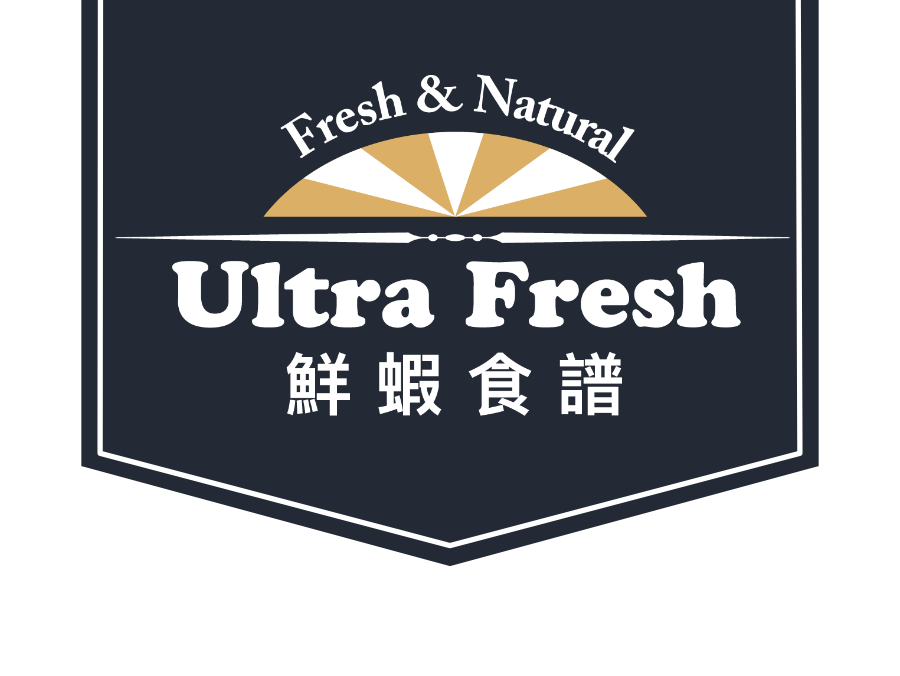

 English
English Español
Español